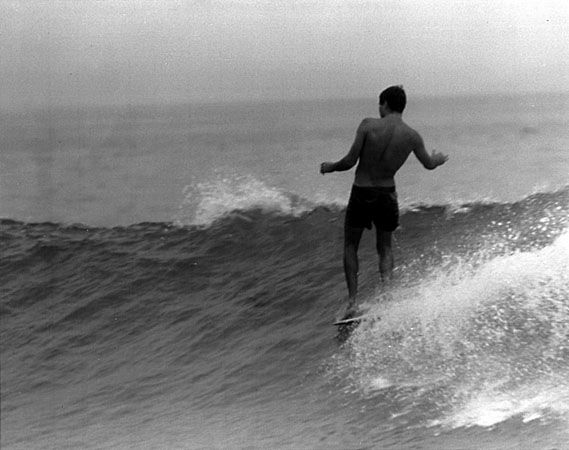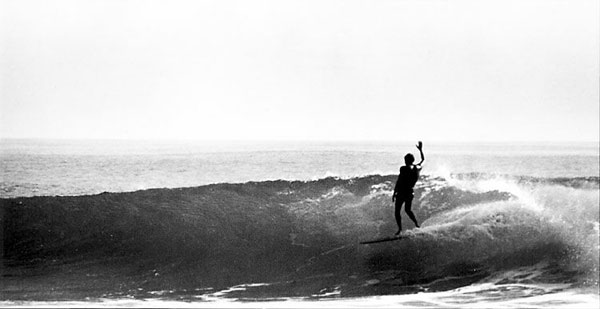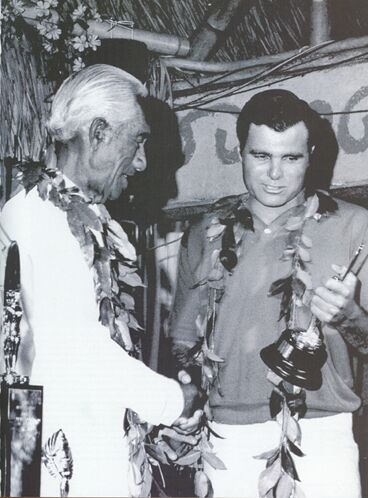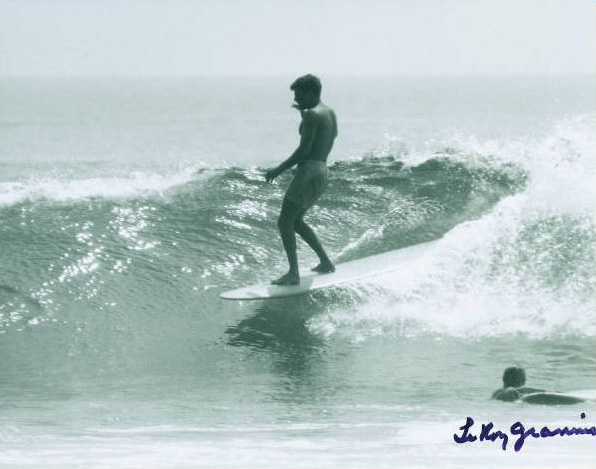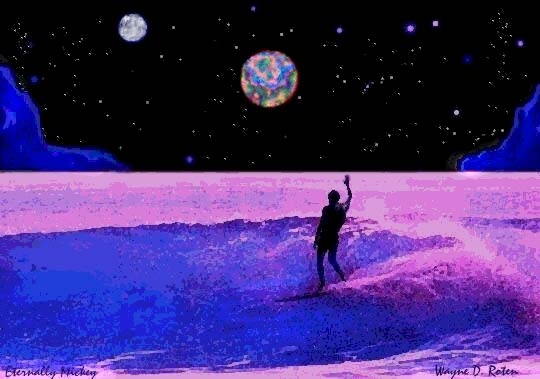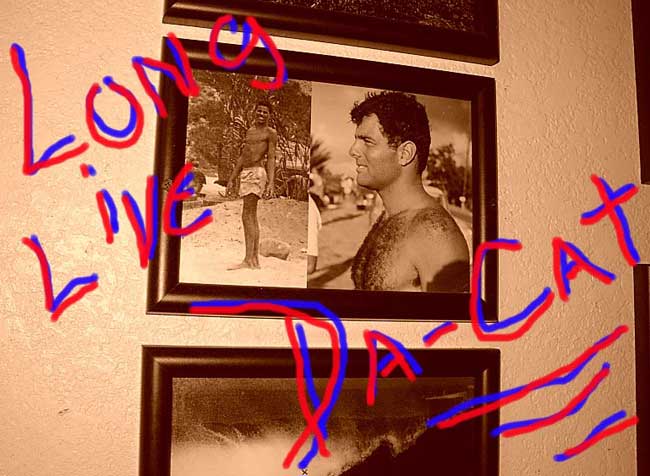domingo, 31 de enero de 2016
sábado, 30 de enero de 2016
jueves, 28 de enero de 2016
Interview with Al Knost: OC Freesurfer of the Year bY www.ghettojuicemag.com
Interview with Al Knost: OC Freesurfer of the Year

Interview by Skip Snead
Ghetto Juice: First off, Alex, congrats on being named this year’s OC Freesurfer of the Year!
Alex Knost: Thank you very much. I feel very … free.
Ghetto Juice: What comes to mind when you hear the term “freesurfer”? What’s that mean to you?
Alex Knost: I don’t know, really. I guess it’s a way to describe someone who’s not on a tour competing, I can imagine. Just freedom. Freedom to surf how they want.
Ghetto Juice: Did you ever have dreams of being on the tour when you were little?
Alex Knost: Probably. I always longboarded so it wasn’t really an option, because there wasn’t really a tour. I mean, there was but there weren’t many people who made a living off it. There were guys who did longboard contests … guys were getting like a thousand bucks for winning a contest or something, so it wasn’t really like a feasible profession for anyone. There were like two guys making a living off it, like Joel (Tudor) being one of them, but I don’t think his accomplishments in competition really afforded him a paycheck.
Ghetto Juice: How did you get into longboard as opposed to shortboarding when you were a kid?
Alex Knost: My dad got me into longboarding. My dad and his friends were the first surfers I knew, and they rode longboards and that’s what they surfed. They went to San O, Malibu and Blackies. So for a nine year old kid, you really don’t differentiate from much, you just try and do it. So I just did it. There was kids who surfed (longboards) in high school and stuff, but there weren’t many kids as die hard as I was, or even in Junior High. My dad would go every day before work, and we’d go on the weekends. Most kids that I knew weren’t really, well, I just didn’t know them. The easiest way to go surfing as much as I could was to go with the people who were doing it the most, which was my dad and his friends.
Ghetto Juice: What moments do you remember from your early days on a surfboard?
Alex Knost: I remember the smell of Bubble Gum surf wax. Bubble Gum surf wax stickers on coolers at San O. All my dad’s friends all had Igloos full of beer, and they always like a Bubble Gum surf wax sticker on it, a Da Bull sticker … everyone had these bumper stickers that said “Miki for Prez because Bush don’t surf” … what else do I remember? San O, hanging out there all day, and surfing Blackies before school when it was one foot and south wind every day. Just being obsessed with surfing. I could never get enough of it. I’d wake up my dad at five o’clock in the morning. I’d bang on his door and go, “Let’s go surf!” And he was pretty psyched on it, too, but he worked pretty hard his whole life painting houses, so he was pretty beat every morning, but I thank him for that. I thank him for getting up and getting me out there.
Ghetto Juice: What kind of surfboard did you start out on?
Alex Knost: Let’s see…. I was like 12 and I had an 8-foot Russell, it was really thick, a tri-fin longboard that was made in the early ‘80s. It was like my dad’s friend’s old board or something. I rode that for a while, but I got jealous of all the guys at Blackies, cause they had these bitchin single fin nose riders, guys who were older than me, guys like Steve Farwell and Cody Simkins and those guys, and George Wally, and Bean Dip. They all had these like big Joel Tudor style longboards, Model T Takiyama type noses, and big noses, like David Nuuhiwa models, and I always wanted one but I could never get one, because everyone I talked to, like Robert August and Mike Marshall, they wanted me to learn to noseride the right way, and thought that a “giant” nose was cheating ‘cause you wouldn’t have to noseride in the pocket, so I sat there and felt like a kook ‘cause I always wanted one of those big noses that I could hang ten on, and my dad and Mike Marshall and Robert August would only make me these tiny noses, I guess to get me to walk before I could run, or something like that. I never felt cool. All the older guys had big tip noseriders (laughs) and I didn’t.
Ghetto Juice: Interesting. During that time was there any pressure from your peers your own age to ride a shortboard?
Alex Knost: I don’t know, the two were separated. I mean, I rode shortboards in high school on the surf team (Newport Harbor) but it was just different for me. I think even in middle school, seventh and eighth grade I had a couple friends who shortboarded, so I’d surf before school and on the weekends with my dad, and if I wanted to surf after school I’d get a ride with my friend’s parents and when I’d bring a longboard in their car they’d look at me like a dipshit, you know, a mom trying to fit a longboard in her minivan or Honda Accord. She’d say something like, “Why does your friend Alex bring this big board?” So sometimes out of necessity I’d ride shortboards, and it was cool, too. I mean, I got made fun of a little bit but I didn’t care. I knew this whole world of people who rode longboards, and who hung at San O, and that was what I was addicted to anyway. You could just hang out there all day anyway. Where in Newport it was a touch and go sort of thing. You surf in the morning and then it’s blackballed. Where I’d go to San O with my dad, or with friends who were older that drove, we could get down there at six in the morning and leave at seven at night. It was an all-day thing.
Ghetto Juice: Was it there at San O that you really improved fastest in your surfing?
Alex Knost: I’d say Blackies. I’d do all the club contests with my dad, but that was more family oriented. We’d go up to Santa Cruz or down to La Jolla, but Cody Simkin was the best surfer I ever knew, probably one of the best surfers I’d ever seen, and I remember he’d take me to the beach, he was older than me, and we’d surf all day. And as soon as I got a car when I was 16 it was pretty much game on. I had a couple friends, like Nolan Hall and a couple other people and we’d either go down to San O or Cardiff for weeks at a time. We’d go to San O and surf all day, then go to the skatepark in San Clemente after, right when they opened that up, and then we’d go to Wal-Mart and we’d steal socks ‘cause our socks smelled so bad, so we’d steal socks, and sometimes jeans, but mostly socks. And then we’d go back to the beach and we’d surf and then we’d talk our friend Jeremy into buying us beer and we’d drink and sleep in the car. We did that from the time I was 16, every summer, all summer, until …. Now. You know, I sleep in a van now, not a station wagon, and I don’t have to steal socks anymore. (laughs)
Ghetto Juice: Yeah, you probably don’t need to steal socks anymore…
Alex Knost: (Laughs) No. Don’t have to steal socks.
Ghetto Juice: How old were you when you got your first legitimate sponsor?
Alex Knost: Ummm, well my dad was friends with Mark Martinson and Robert August and they were shapers, and they were awesome, and they kind of held a carrot in front of my face. Like if I got good grades they’d make me a new board. I think Robert gave me my first board, it was a “Wingnut” model, right after Endless Summer 2 came out, had the two red stripes. That was my first custom board. It was an 8’4” … it wasn’t even technically a longboard, but I remember I ordered that and I was all excited he was making me a custom board. And I went to leave and I was like, “Thank you so much, Robert, I can’t wait!” And I came back a few weeks later and he was like, “Yeah, your board’s almost done, the one with the pink bunny rabbits on it!” And I was like, “What? Pink bunny rabbits??” And he said, “Yeah, remember? You wanted the pink bunny rabbits, that’s what we got, it’s airbrushed all killer…” I was like, “F—k, man! I’m gonna be the biggest kook, everyone’s gonna make fun of me!” But he was just f—-kin’ with me, that was just Robert’s vibe. So I got that board from him. Around the same time, Surfside Sports when it was down by Blackies, that was kind of the cool thing, all the older guys rode for Surfside, like Josh Hoyer and Maikai McKenna and Steve Farwell and Bean Dip … and I got a bunch of free stickers, a couple t-shirts from Surfside Sports and that was like the coolest thing for me. And then later, I remember the Frog House guys, like TK and stuff, and I’d be like, “Am I a kook riding for Surfside? Should I be a Frog House guy? I wanna be a Frog House guy!” (laughs) It was the funniest shit.
Ghetto Juice: So did you end up riding for Frog House?
Alex Knost: No, I didn’t, and TK just makes fun of me every time I see him. Still, to this day. TK rules. Yeah.
Ghetto Juice: Were you a big fan of Endless Summer and all the old surf movies from the 60s?
Alex Knost: Yeah, even though I was born in ’85, from 1990 until like 1997 my dad would drag me to all these parties, and all the guys would watch movies and get all drunk, and all the surf guys who had kids, we’d all get locked in a room, you know, “Hey you guys just hang out in there…” and they’d watch all the old movies and drink beer, all the videos from their era, from the movies of the late 50s through the early 70s, the Australian transition era, and the Greenough films, all that stuff. So we were just brainwashed, sitting there all weekend at these parties. All the parents would be out doing what they were doing and we’d be in this room watching surf movies getting stoked.
Ghetto Juice: That’s rad that you developed such an appreciation for that side of surf culture during a time when surf movies based on hot shortboarding were really all the rage….
Alex Knost: Yeah, when you’re a kid you’re a sponge. You don’t think about it. You just sat in front of the TV. By the time I got to high school people were watching Kelly Slater in Black and White and that was a whole new thing to me. That was out of my peripheral.
Ghetto Juice: But you still ripped on a shortboard, so that’s kind of cool, too.
Alex Knost: (Laughs) I don’t know if I ever ripped on a shortboard, but I liked it. I had a lot of respect for any type of surfing, from a PT type guy to someone like Derek Hynd on the finless boards, or big wave guys. That’s probably the craziest thing to watch, some of the crazy guys surfing Hawaii the past five years or so. That’s pretty cool. I think that’s pretty awesome.
Ghetto Juice: Where did you end up going on your first surf trip?
Alex Knost: Costa Rica with Robert August. Yeah he told me if I got A’s and B’s in school he’d take me to Costa Rica, so I just cheated…. For two years, just cheating off every girl I could find so I could get to Costa Rica (laughs).
Ghetto Juice: Did you like school?
Alex Knost: (Pauses) Um, well …. No. I didn’t like it at all. But it was laid out for me from an early age. From my dad. “All right, Alex, if you do this, sack up, be a man and do something you don’t like, and keep your head out of your ass, you’ll get to do all the shit you like. But if you blow it, you’re not gonna surf.” It was more the carrot over my head.
Ghetto Juice: Did you see yourself being able to make a living from surfing or were you thinking you might have to get a real job one day like your dad and his friends?
Alex Knost: Yeah. I think, yeah, for sure. All my dad’s friends were construction workers and house painters and stuff, and they were all surfers. You know, getting sponsored I never made any money, and I won some contests, and when you’re a little kid you win a little bit of money you think you’re the richest guy in the world, but I don’t know. I worked at the Robert August factory, before the computer, and I would take the hard foam off the blanks, put the rocker in it and I thought it was cool, you know, working in a surfboard factory, and then Jeff Yoki, from Modern Amusement, gave me a job just scribbling art to put on his t-shirts, when I was like 17, I was still in high school, and so that kind of felt like being a pro surfer. And then I went on a surf trip with Dan Malloy for Thomas Campbell’s movie, and Dan Malloy knew that Conan Hayes and Pat Tenore were starting RVCA. I was about 17 or 18, I was just getting ready to move out of my parent’s house, and the phone rang at like three in the morning. I think Pat thought I lived without my parents, and said he’s got this brand RVCA and asked me if I wanted to ride for a clothing company. My mom had to come in my room and hand me the house phone, she said “There’s some guy named Pat on the phone who said he needs to talk to you.” I still laugh about that, because Pat talks like a million miles a minute and he probably didn’t realize I lived at home and that he’d called me at like three in the morning.
Ghetto Juice: You've been riding for RVCA for a long time!
Alex Knost: Yeah, well, Matt and Ford Archbold were already riding for them, and in all their ads, but yeah, it was right when it started and I think it had just moved the company out of their garage … So then I got a job. I got the free ticket (laughs). The meal ticket.
Ghetto Juice: And you combined that with the music. How did you get into that?
Alex Knost: I was always kind of into music. My dad got me into Neil Young when I was pretty little, and The Cars and Fleetwood Mac and all that shit, you know, driving down to San O on blank cassettes. And then I started skateboarding next, and going to skateparks and hanging out with all those punker dudes, like Mike Lohrman from The Stitches and Gish from the Smut Peddlers, and Ricky Barnes, and Grosso and all those guys, they were all skaters. So I was kind of born into this hippy Neil Young thing and then went to the skatepark and there were these tattooed gnarly looking guys, Duane Peters and shit, and I was like, f—k, these guys are really cool, I like the punk rock thing: skateparks, punk rock, tattoos and chicks. So that got me into music even more, you know? And Nolan Hall and I, we were longboarders, surfer friends, and we started our first band Japanese Motors and we just played in my friend’s living rooms, all teenagers, and Chase Stopnik, the bass player, he crashed there. He was like a skate punk kid, he just smelled so bad, never took showers (laughs) … Yeah I dragged my parents through some commitments in those days.
Ghetto Juice: What do you like better? Performing on a stage or on a surfboard?
Alex Knost: Ummm, I don’t know. Surfing you’re not really thinking about an audience, which is kind of cool. You don’t even have time to think about an audience, just a head down type of thing. Sometimes music, the response is so immediate, you know, it’s easy to feel rejected if everyone’s not going apeshit, looking at you like you’re the best song writer in the world, you get self-conscious, but I really like recording music. Yeah, I think I was a little more self-conscious playing live when I was younger but now (in Tomorrow’s Tulips) it’s more like who the f—k cares, just do it and have fun.
Ghetto Juice: Yeah, and you’ve got Ford in there, too….
Alex Knost: Yeah, it helps to be in a band with Ford because he’s so detached from any sort of like … I don’t know, Ford’s an Archbold. He just don’t give a f—k. He just enjoys life, doesn’t care what anyone thinks. He’s a good person to be around to help you remember that everyone’s gonna die eventually, it doesn’t matter, just enjoy yourself and feel good and make other people feel good. That’s cool.
Ghetto Juice: How would you describe the last ten years of your life?
Alex Knost: Lucky. Amazing. Far out. Exceptional. Yeah, grateful. I’m super grateful to have met so many cool, unique people through surfing and so many inspiring originals. All the people who did all this amazing stuff, and all these incredible things without any expectations of recognition. I think that’s the coolest thing, meeting real awesome surfers and board builders and artists, all these people who did it for fulfillment. One thing I’ve noticed with all the internet and online stuff and self-promotion, I feel like people do get caught up in it and they only do things just to put on their Instagram, just to show people how cool they look and how cool they are to flip off their sponsors. I don’t know, I’ve just met so many real awesome people that were so ahead of their time and just did it because they loved surfing, or they just loved whatever they’re into. I’ve always thought that was so cool.
Ghetto Juice: What advice do you have for the kids out there who might be reading this, in terms of living their life?
Alex Knost: Be grateful and stay modest. Everyone’s the same.
Ghetto Juice: And how do you see the next ten years playing out for you?
Alex Knost: I don’t know, I’ll just take it a day at a time.
Special thanks to Laylan Connelly and the entire OC Register staff for letting us be part of the OC Surfer of the Year awards for the fourth straight year!
Posted by:
http://www.ghettojuicemag.com/blog:alknost
miércoles, 27 de enero de 2016
martes, 26 de enero de 2016
viernes, 22 de enero de 2016
lunes, 18 de enero de 2016
jueves, 14 de enero de 2016
miércoles, 13 de enero de 2016
myles
myles from nick ventura on Vimeo.
We Rise Together
We Rise Together from Scopo Studios on Vimeo.
Billy Death Fantastic Man
Billy Death Fantastic Man from Tv Dinner Motion Pictures on Vimeo.
A memorial to Billy Death . Rest in Peace . 1983 - 2015
martes, 12 de enero de 2016
Sunny Coast // MS Surfboards
Sunny Coast // MS Surfboards from Kieran Harris on Vimeo.
"We're just trying to create an environment where everyone feels equal and wants to have a good time"
Mitch Surman
MS Surfboards located in Maroochydore on the Sunshine Coast of
Australia are inspiring the world with their fun filled laid back
lifestyle where everyone can be apart of the team.Mitch Surman
Glass Coffee House and Surf Gallery is their shop in Maroochydore.
Josh "Sea Monster" Seemann
Sea Monster. from CJ Nelson on Vimeo.
We caught up with Josh "Sea Monster" Seemann to watch him surf his 9'5" XEON Classic at his home break in Carlsbad C.A. We we're blown away and inspired watching him make the less than average conditions look like a walk in the park. Check Josh out on Instagram at @seemonnster. Thank you for watching.
lunes, 11 de enero de 2016
domingo, 10 de enero de 2016
sábado, 9 de enero de 2016
viernes, 8 de enero de 2016
TYLER WARREN DEPARTURE
DEPARTURE from Robots From Outerspace on Vimeo.
Mike Stidham
Mike Stidham from Birdman Media on Vimeo.
Chad Marshall VENICE
Venice from Torrey West on Vimeo.
BUMMER WITH TRACE MARSHALL
BUMMER WITH TRACE MARSHALL from Torrey West on Vimeo.
jueves, 7 de enero de 2016
XPEEDIN’ Surf Retro Culture de España by xpeedinsurfschool
XPEEDIN’ (Una pequeña gran historia)
Por Laura Revuelta (co-fundadora de XPEEDIN)
Al final del verano del 77, termina Gerónimo-Surfboards. Mariam e Iñigo (Pukas) y Zalo y Laura (Xpeedin’), comienzan sus nuevos proyectos.
Xpeedin’, pone a funcionar su taller de tablas en una casa de pueblo, donde las mesas de trabajo, eran los pesebres de la cuadra. En el pajar, conviviendo con ratoncitos de campo y lechuzas, había una curiosa tienda-taller, donde se confeccionaban, fundas para las tablas, inventos, mochilas, bikinis, collares…… y poco mas .

En este tiempo, comienza a construirse, un edificio a pie de playa, en Somo y arranca XPEEDIN’ SURF SHOP estas tres palabras ya eran raras de por si en aquel entonces…..
El día que se “inauguró”, simplemente, fue llevar las cosas del taller a la tienda, y dejar la puerta abierta. Los clientes había que ir haciéndolos poco a poco. No teníamos prisa.

Para acceder a la tienda, tenias que atravesar un tablón de obra, para salvar el agujero que había delante de la puerta. El edificio estaba sin terminar… la “calle“ sin urbanizar … (era todo arena) y no había ni luz ni agua.
En un radio cassette conectado a una batería de coche, sonaban Jethro Tull, Santana, Led Zeppelin…. Crosby Stills Nash and Young… y… poco después empezó a sonar… un tal Bob Marley, que aun continua…

El primer verano, lo pasamos sin luz, con un farolillo de Camping Gas… así que los días de sol, eran aun mejor recibidos. El teléfono llego pocos años después.
Era increíble… sin hacer publicidad y con esos medios, (ahora impensables) la gente llegaba desde Cádiz o Galicia…. a comprarse una tabla y un invento, conocía la tienda, surfeaba y quedaba en volver otro verano…. y así poco a poco se va escribiendo la historia… no la de Xpeedin’ sino la de cada persona que nos visitaba y mas tarde recordaba haber comprado su primera tabla… haber participado por primera vez en un campeonato…. haber conocido a la chica de sus sueños… y tantas historia…

Todos los años se hacían reformas y cambios en la tienda, siempre de forma artesanal y con su propio sello de identidad.
Xpeedin’ era un centro de reunión… un club… un sitio de paso para la playa… un lugar para apuntarte a un campeonato… o simplemente un sitio para charlar… nunca ha querido ser solo una tienda donde comprar material técnico o ropa cómoda.

Una Surf-Shop es un espacio donde seas surfero o no, cuando nos visites, te encuentres a gusto y no te sientas obligado a comprar sino solo a conocer un poco mas la esencia del surf.
Xpeedin’, siempre cuidó mucho sus escaparates. Muchos niños han dejado kilos de cáscaras de pipas… soñando con las fotos de olas o maniobras que veían… suspirando por el traje… o tabla expuestos… o simplemente disfrutando del colorido y las cosas tan desconocidas… que tenían que entrar a preguntar que era.

Son muchos, los que ahora vienen con sus hijos a enseñarles la tienda y recordar veranos de playa sol y risas. Son tantos años… que algunos traen a sus nietos…
De aquellos míticos campeonatos Xpeedin’ y de aquellos niños que Xpeedin’ vio nacer… llegó el cambio generacional.
La esencia sigue viva, XPEEDIN’ no es una tienda es una SURF SHOP………….. hasta siempre.

XPEEDIN SURF
Por Capi & Nachete
La historia de XPEEDIN SURF SHOP, va unida a la historia en la vida de dos de los mejores surfistas que jamás ha dado nuestra tierra; Zalo Campa y Laura Revuelta. De todos son conocidas las historias de la mítica Gerónimo, en San Sebastian y la Casa Lola, en Loredo … hasta que a finales de los 70 abrieron la 1era tienda de surfing en Cantabria y pionera en España, que ayudaría a la progresión del surfing de toda una generación, de la cual pertenecemos mi hermano Nachete y yo, que tomamos el relevo hace ya algo más de 10 años.
Xpeedin Surf Shop se encuentra en primera línea de playa, en Somo y desde sus comienzos ha sido una tienda pionera en surfing, con un “feeling” muy especial, el cual nosotros hemos tratado de conservar y mantener.
Zalo y Laura estuvieron en la surf shop casi 30 años y espero que mi hermano y yo al menos continuemos esa misma trayectoria otras cuantas décadas.
En los comienzos Zalo y Laura se curraban todo, la serigrafía de la ropa, que copiaban de otras marcas, ya que entonces no existían las distribuidoras, los bikinis y la bisutería que se curraba Laura, además de toda la ropa Xpeedin… y todo ese corazón que pusieron en la tienda, como siempre dio sus frutos. Nosotros de pequeños flipabamos cada vez que nuestros padres nos llevaban a Xpeedin y siempre tratábamos de sacarles algo. Nuestros primeros paipos, nuestros primeros trajes, nuestras primeras tablas, nuestras 1eras ropas de surfing, todo pasaba allí. Para nosotros entrar en la tienda y escuchar las historias de los mayores era dar vida a nuestra imaginación. Sentarse a ver las photos y ver las tablas, las primeras Black Xpressions, posteriormente Pro Series y toda la magia surfera que allí se respiraba era inolvidable.

Luego estaba el club Xpeedin y los campeonatos que organizaban, que ahora que los hacemos nosotros, lo valoro incluso más…. y algo que a mucha gente se le ha olvidado, es que en la calle de Xpeedin no había coches y lo que si había era una rampa de skate, en la que nosotros nos pasábamos todo el día.


Fueron unos años increíbles y con los años, hemos ido teniendo mucho más contacto con Zalo y con Laura y les tenemos un afecto y un cariño inmenso, no sólo por el hecho de pasarnos la tienda, sino a nivel surfístico, emocional, personal. Mucho de lo que pasa hoy en día en el surfing en España se lo debemos a ellos y a otra mucha gente, pero en Somo, especialmente a ellos. Son 2 personas auténticas, mucho más hippies de lo que parecen jeje y tengo mil buenos recuerdos con los dos en el agua. Son 2 surfistas increíbles y muchas veces me da rabia que no se les halla valorado el gran mérito y la cantidad de puertas que han abierto a muchos de nosotros, tanto a nivel de sponsorizaciones, campeonatos…. Hablar de ellos es hablar de la historia del SURFING y nuestro máximo respeto hacia ellos.
En el 91 cuando montamos la ESCUELA CANTABRA DE SURF, Zalo nos ayudó mucho y nosotros pienso que también a ellos y que fue algo reciproco, porque esos primeros años, nosotros llevamos a nuestros alumn@s de la mano a su tienda. Luego con los años, nosotros montamos una pequeña tienda y los comienzos fueron duros, porque Zalo y Laura trabajaban las mejores marcas y estuvimos muchos años así, hasta que algunas marcas empezaron a servirnos. Siempre Zalo y nosotros fuimos de frente y pienso que por eso, la relación que hemos mantenido siempre ha sido muy buena.

Después de unos años surgió la posibilidad de coger Xpeedin de sus manos y fue algo que pensamos muy mucho, pero que al final hicimos y que a día de hoy no nos arrepentimos, es más nos ha enseñado mucho y agradecemos toda la ayuda y todo el apoyo que Zalo y Laura nos han prestado. Ese respeto y ese amor que ellos pusieron en la tienda, creo que le hemos mantenido, se han hecho algunas mejoras y algunas reformas, pero la esencia sigue intacta.
Seguimos trabajando la marca Xpeedin Surf Shop, seguimos haciendo la ropa, las tablas Xpeedin Surfboards y nos seguimos currando todo, como si de alguna forma tuviésemos un legado y una responsabilidad.

Muchas veces cuando veo a los niñ@s entrar en la tienda y veo su brillo al ver las fotos, o cuando sus padres se enrollan y les compran una tabla o un traje, me recuerdan a mi cuando era pequeño.
No se trata de un simple negocio, para nosotros es mucho más espiritual que todo eso, se trata de dónde nos hemos criado y cultivado como surfistas, es un negocio pequeño, dentro de un pueblo pequeño, pero se pone un gran corazón, para que la gente cuando entra, sienta que esta en un lugar mágico, que encierra dentro de él, mucha de la historia de surfing de esta tierra, mucha fuerza y esperamos seguir como hasta ahora.

Jamás pensé de pequeño, que acabaría llevando la tienda que enriquecía mis sueños y mis ilusiones surferas de pequeño, pero ahora que el sueño es una realidad, me siento un privilegiado, porque me permite llevar la vida que siempre perseguí tener, currar cerca de la playa, para poder surfear y tener tiempo, para mi, mi familia y para mi surfing.
Xpeedin Surf Shop es parte de la historia del surfing en España, es parte de la vida de Zalo y Laura, ha sido parte de nuestras vidas, lo es ahora más que nunca y es parte de todas aquellas personas que quieran pasar a conocerla. Os esperamos a tod@s. Jah Bless U.
TEXTO: David García “CAPI” & Nachete García.
PHOTOS: XPEEDIN SURF
“Desde 1977 comprometidos con el surf”
Hastagh #XpeedinSurfSomo
http://www.xpeedinsurfschool.com/historia/
miércoles, 6 de enero de 2016
martes, 5 de enero de 2016
lunes, 4 de enero de 2016
domingo, 3 de enero de 2016
In celebration of an artist and his art "MIKI DORA" by http://www.surfwriter.net
|
Miklos Dora - 1934 to 2002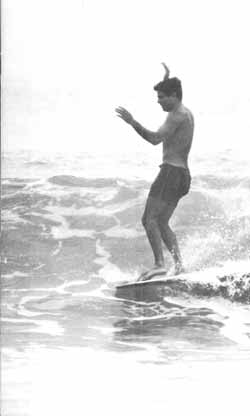 Miki Dora at Malibu - November 1964 issue of Surfguide Magazine - photograph by Leroy Grannis |
|
In July 2001, when I first learned that Miki Dora
was seriously ill, I dismissed the news as just another rumor in a
colorful life plagued by rumor. Besides, it seemed unlikely that a man who
had always radiated such vibrant health could now be fighting for his
life.
Months later, I heard the news again. This time
from an mutual friend who’d known Miki for well over 40 years. This time
I couldn’t dismiss it as idle gossip.
According to my friend, Miki had developed a
rampant form of cancer that ruled out anything but palliative care. He’d
left France, where he’d lived and surfed for much of the past
twenty-five years and was spending what time he had left at his father’s
home in Montecito. He’d come home to die, “as gracefully as
possible.”
|
|
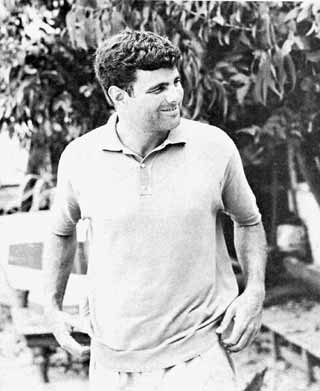 |
As I was rapidly approaching my ‘big-six-oh’,
I’d already had to accept the increasing loss friends and family.
Death comes with the territory and, all too often, one doesn’t get a
second chance to say goodbye. So I decided to write to Miki from my home
in Aotearoa New Zealand.
I know that Miki received a number of visits and
phone calls from old surfing mates over the next couple of months and I
heard that he was moving painfully towards the end of his life with
courage, dignity and humor. I also know that he read my letter.
In it I thanked him for his contribution to my
life by recounting the first time I’d seen him surf and describing the
impact of that experience. Finally, I wished him well on his
“continuing journey,” as that is how I chose to look on the
transition we call ‘death’.
|
Miki at Topanga
Beach circa 1964
Photographer unknown at present, but probably Bill Cleary |
|
“When
there’s surf, I’m totally committed.
When there’s none, it doesn’t exist.”
The first time I saw Miki Dora was a defining
moment in my seventeen year young life and one for which I will always
be grateful.
It was the late 50’s and I’d been surfing
just long enough to feel confident about thinking of myself as a
‘surfer’ and trying to look and act the part as well. In that short
space of time, surfing had become a ‘way-of-life’ for me and just
about everything I did, said, thought or planned revolved around what I
considered to be my ‘sport’.
For a couple of months after I caught my first
wave, I confined my surfing to Point Dume, where I’d learned to stand
up, and Latigo Cove, where my girl friend’s family had their home.
From there I ventured out to all those challenging and diverse North Bay
breaks between Hubbyland and the Lighthouse.
|
|
|
Although I hadn’t yet met Dewey Weber, I was
unconsciously following the advice I’d later hear him offer to other
apprentice surfers: “Learn at a nice right point break and that’s
the only kind of wave you’ll know. Learn at beach breaks, jetties,
points, breakwaters and reef breaks. Take off on every wave that comes
along: lefts, rights, mush, crap, even closeouts. Then you’ll be ready
to ride anything.”
Slowly, by trial and error, I learned how to surf
and started going out at Malibu.
On that particular day I’d walked down past the
‘Wall’ and was squatting up on the cool, dry sand above the tide
line with my board balanced across my lap. It was one of those special
early mornings when the air buzzes with light. A hint of desert in the
light offshore feathered across my bare back and sent raw shivers of
excitement throughout my body.
|
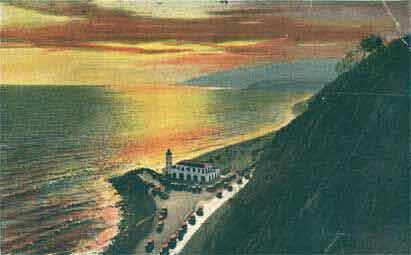 The Lighthouse circa 1930 - now demolished to make way for the box-like building that houses the LA County Lifeguard headquarters. When the rock 'jetty' or groyne seen in this old postcard was extended it created a fast, hard breaking right break that was great - if you made it. |
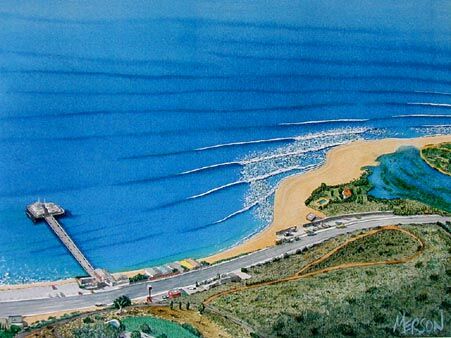 Malibu Morning - painting by Bob Merson. Please click on his name to see more of his work. |
The sun was less than an hour old and there were
already five or six guys out in the water. Another couple were now waxing
up in the ‘Pit’. But Malibu was still new to me and the inshore rocks
sharp and unforgiving. I was content to spend a few more minutes checking
out the waves and wondering about the best place to paddle out.
Suddenly my attention was drawn to a distant figure
taking off on a beautifully shaped shoulder-high wave way out at the
Second Point. It was like becoming aware of a focus of intense energy and
I stood up to get a better look.
|
|
What amazed me at first was that whoever was riding the
wave had made it all the way past the first point and was still going. Then, as
the surfer got closer, his board appeared to be sliding back and forth all on
its own.
Was it the board moving under the surfer, or was it the
surfer moving up and down the board? It was like magic; like watching someone
far more subtle than Michael Jackson doing a barely perceptible ‘Moon Walk’
to stay in perfect trim. The finesse. The control. The pure, unparalleled
artistry.
|
|
|
Up until that moment, I had looked upon surfing as a
sport, and surfers, myself included, as players who competed against each other
to see who was ‘the best’.
With my new friends and acquaintances I’d sit on the
beach or stand around in parking lots judging whoever happened to be surfing at
the time. Every once in a while someone’s ride would be overwhelmingly
acclaimed and the surfer receive a popular accolade such as, “really good.”
But most of our energies were spent on criticizing each other and trying to
convince ourselves how much better we would have done had we been on the wave.
|
|
|
Even now I’m embarrassed to admit that I wanted to be
the guy about whom they’d all say, “Wow! He’s a really good surfer.” I
wanted people to recognize me when I walked onto a beach or into a surfing
movie. I wanted to be respected for my amazing surfing ability and skill. Not
that I had a snowball’s chance in hell of achieving any of this, but that’s
what my seventeen year old intellect thought surfing was all about. I was
surfing to be noticed.
|
|
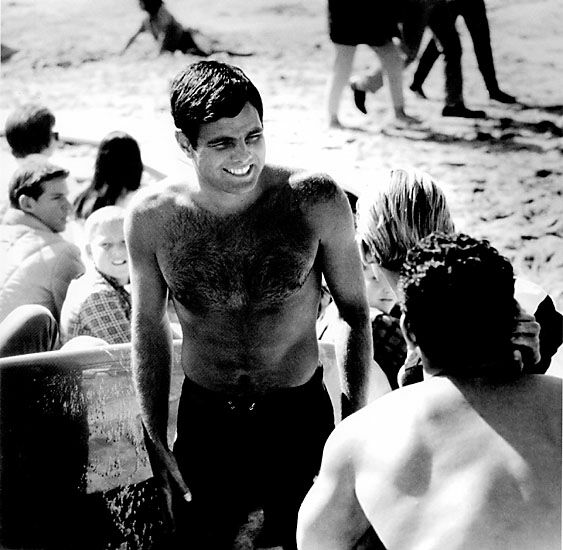 Photograph copied from an internet site was unattributed. Any information would be appreciated. |
In a gradual but very powerful way, seeing Miki Dora on
that single ride changed all that.
Firstly, by opening my eyes to the exquisite beauty and
grace of someone else’s surfing and the tremendous enjoyment that virtuosity
could engender.
Secondly, by planting the seed that eventually grew into
an understanding that surfing was no longer about me and other surfers. It was
about me and the wave. Each wave special. Each wave new. Each wave worthy of my total
commitment and respect.
Surfing was no longer the statement by which I expressed
myself to the world and wished to be recognized in return. It was an absolutely
personal experience that didn’t require an audience or anyone else’s opinion
to validate. Surfing was mine.
|
|
It was Miki who introduced me to the essence of that
passion and solitary joy of surfing. And that has been one of the greatest gifts
of my life.
“Thank
God for a few free waves.”
Bill Cleary also had clear memories of his
first experience of seeing Miki surf at Trestles when Bill was still in the
Marine Corps:
“At the time I fancied myself a
good enough surfer to appreciate the subtle things he was doing out there, but I
really didn’t have a clue. It would be another ten years before I really
understood the subtleties: and that far from being good Mickey Dora was a surfing genius.”*
|
|
|
Bill had one of those “on again, off again”
relationships with Miki that kept everyone guessing whether they where really
friends or really enemies. They’d insult each other in public and laugh about
it later in private.
“When someone is exceptionally
talented, we tend to think of him in terms of extensions of our own abilities.
|
Bill
Cleary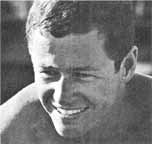 |
|
Those who can multiply ten figure numbers or do square roots in their heads, we
assume to be just like us except that they were born knowing some kind of trick.
Nothing could be farther from the truth. Like a Michelangelo or a Mozart, Mickey
had a heightened sensibility born of something akin to a sixth sense. But that
does not nearly do it justice - no, it was more like Mickey Dora was born with
an invisible organ, some mysterious faculty homologous to a radio tuned to
higher frequencies. The ‘sounds’ that reached Mickey made up a foreign
language - or perhaps they were more like music or a swirl of color, but
whatever they were, these rarefied intimations contained the wave information
Mickey’s brain hungered for, and which enabled him to surf in ways beyond our
imagining.”*
“The
media is impersonal. They care little whether I live or die.
So what? It’s irrelevant. I know what I stand for, and that’s all that’s important.” |
|
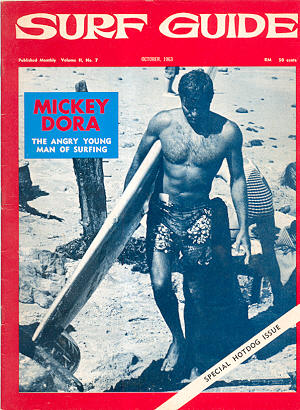 |
While he was editor of sixties surfing magazine, Surfguide,
Bill interviewed Miki for the magazine’s October
1963 issue and later, according to Bill, tricked Miki into giving another interview for
November 1964 "Malibu Issue."
“I gave up trying to talk him
into doing our story the usual way. How could I have ever been so stupid? Mickey
Dora had never done anything in his life “the usual way”, why would he start
now? Instead I rigged a
couple of tape recorders and stashed them out of sight. I wired them into my
answering machine and sat back waiting for Mickey to show up on his own. I
proceeded to interview Lance and Kemp and Morey and Rochlen, knowing word of our
Malibu project was already spreading via the coconut telegraph; and that he
wouldn’t be able to resist. A curious creature, the Cat.”*
Bill’s patience finally paid off:
|
|
“And so it happened. Mickey stopped by one afternoon, we sat outside on the porch, I flicked on the hidden recorders and he took off. I hardly said a word, not wanting to interrupt the flow of Mickey’s classic dialog as he recounted Malibu myth. Fingers flying over the memory beads, he raked through the old stories of Mitch the Masochist, Tubesteak, Gidget, Simmons and Matt Kivlin.
“Listening to the tape later, I
knew I had got exactly what I wanted.
His dialog was perfect. I could print it word-for-word.”*
|
|
|
It is one of the many paradoxes that punctuated Miki Dora’s life that his unconcealed contempt for the surfing media and his unwillingness to share his private thoughts with the surfing public were immortalized by the very medium he despised.
“The
vintage years are over.
I have my memories and that’s it. I want to keep them to myself. I don’t want to share them with a bunch of idiots.”
Bill's Surfguide
interview with Miki had been secretly recorded and, according to Bill, Miki
was furious. Or was he?
In any
event it was followed by other articles, including what some consider an
even more revealing profile Bill did for Surfer when he was the
magazine's associate editor.
|
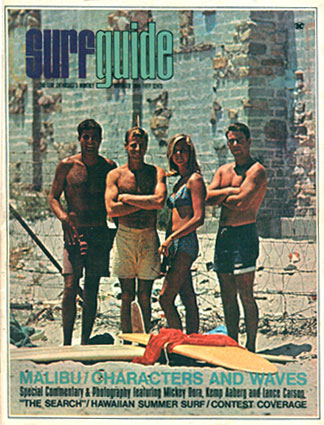 Surfguide's iconic 'Malibu Issue' - November 1964 with Miki Dora, Kemp Aaberg, Mary Sturdevant and Lance Carson |
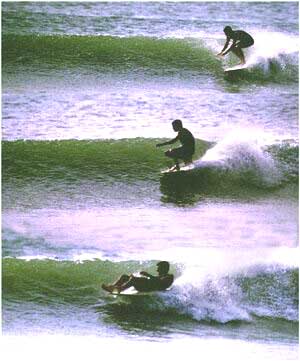 |
“Mickey is not only a genius but
an eccentric one whose personality is so complicated and wound with
contradiction and paradox, that even those closest to him cannot claim to
understand him.”
“One can see everything there is
to see in Mickey Dora when he is surfing.
He is quick, supremely conscious, and he is always the first to know when
the waves are coming and where. His timing and balance defy description. He is
upon occasion even playful out there. He will segué into an impromptu session
of “Quasimodo’s” and “Coffins” and “spinners” or he will simply
surf backwards. For the most part, however, there is no one who takes his
surfing any more seriously than” he does.*
|
| Photos of Miki at Topanga Beach by Bill Cleary |
|
And that is what I will always remember more about Miki
than anything else - his surfing. The way he lived his private life was exactly
that. Private. Whether he was called Mickey or Miki, Chapin or Dora - that was
also his business. It was surfing that defined his life as an artist and to
judge him by any other criterion is to close one’s eyes to the essence of that
art.
In the same way, trying to rank him amongst the pantheon
of surfing greats or comparing him with other artists, such as Phil Edwards or
Kelly Slater would be like trying to compare Nureyev with Baryshnikov. Miki was
in a league all his own.
“Life
is passing time
as gracefully as possible.” |
|
|
Duke Kahanamoku
presenting Miki with a trophy
at the 1967 Duke Contest - photography by Leroy Grannis |
|
“In surfing as in his life,
Mickey Dora has made up his own game, plays it by his own rules, harvests his
own rewards. Nobody understands him. Even those intelligent enough to relate
seldom grasp what he is saying and doing - because the Cat never lets anyone get
too close. He is good at what he does, and he does it with grace and style.
That’s enough for me. People like him should granted special status. Maybe
they should be turned into national parks. At the very least they should be left
alone.” *
|
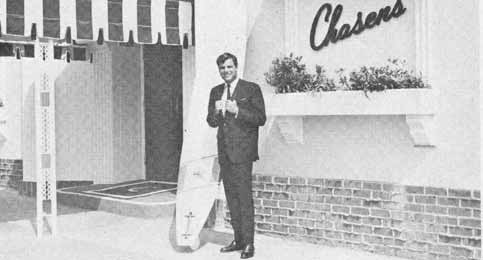 Miki outside Chasens Restaurant with his Morey Surfboard in a photo taken for the 'Malibu Issue' of Surfguide Magazine, November 1964 |
||
|
Left alone to dance with the waves. That doesn’t seem
like all that much to afford an artist of Miki’s eminence. In fact, up until
shortly after I first saw him surf he enjoyed exactly that kind of freedom. But
when things changed it happened quickly and irrevocably. Surfing’s new
generation had little respect for subtleties, art or tradition. All but a few
were “surfing to be noticed” and, like swarms of moths, drawn to nearest
flicker of flame rather than the distant glow of the moon.
I’ve always thought that it must be have been
mixed-blessing that a master such as Miki was only whole when he was in total
communion with his art. But to suddenly have to share the stage with tradesmen,
apprentices and rank amateurs must have been frustrating to the extreme.
It seemed like his frustration turned to a bitterness
that grew in direct proportion to the increasing popularity of surfing itself.
So it didn’t surprise me to learn that he was becoming even more reclusive and
spending his time traveling the world in search of unsullied waves. I was just
sorry that I wouldn’t see him surf again and when he turned up one day in
Gisborne, New Zealand (where I’d temporarily settled during my own search), I
was pleased to learn that he’d been successful in his quest.
Of the last 25 years of Miki’s life I know little
except that he was once again able to enjoy that precious, inviolable communion.
May his soul continue to surf joyfully in the hand of God.
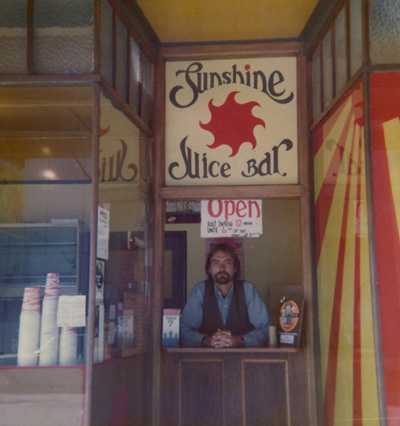 Me at the juice bar, Gisborne, New Zealand circa 1975. Sign reads, "Open just before 12 noon until 6pm or so ..." Surfer's hours. Miki walked up one day out of the blue and asked me what was in a smoothie. I answered, "Milk, banana and honey plus anything else you'd like me to add, like fruit, yeast, eggs, carob, protein powder and so on." Miki said he didn't drink milk and didn't eat honey. "Can you make me a smoothie without milk and honey?" So I whipped him up a smoothie made with freshly made apple juice, banana and raspberries, and he said I could call it a "Smoothie a la Miki" if I wanted.
In
celebration of an artist and his art
© Robert R. Feigel, 2001, 2002 - All
rights reserved
*From:
‘Nine Lives of Da Cat’ - part of an unpublished selection of short stories
titled “Surf
Songs,”
by William Cleary © 1998-99
MIKLOS DORA - AUGUST 11, 1934 to JANUARY 3, 2002 |
|||
| From
a tribute photo published on the internet by BK (aka Big
Kook) shortly after Miki Dora passed on - photographer of the original photos on wall unnamed. Click on photo to link to Memories of a Wavemaster - Saltwater Damage. 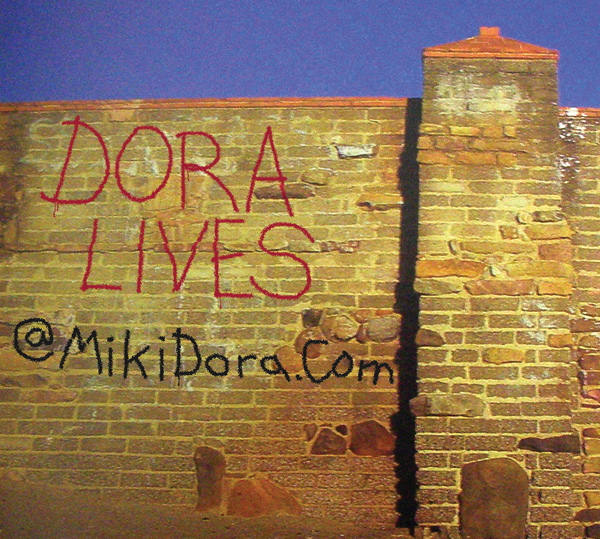 Click this link for an article about what happened to Miki's trophy from the 1967 Duke contest as well as a virtual treasure trove of his other memorabilia. Please visit MikiDora.Com and visit our Facebook Page read the review: ALL FOR A FEW PERFECT WAVES The Audacious Life and Legend of Rebel Surfer: MIKI DORA http://www.surfwriter.net/mikis_tribute.htm | |||
viernes, 1 de enero de 2016
Suscribirse a:
Comentarios (Atom)


